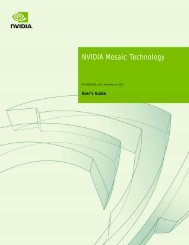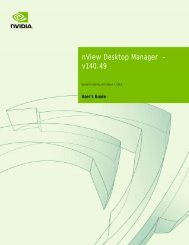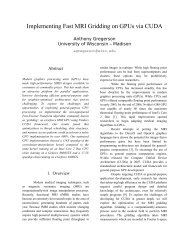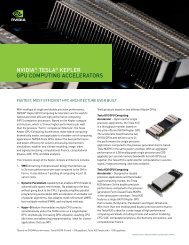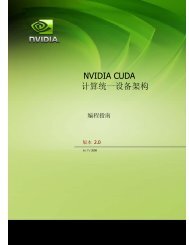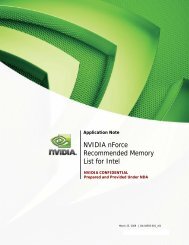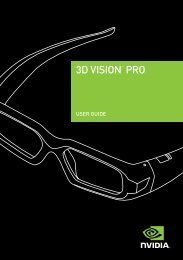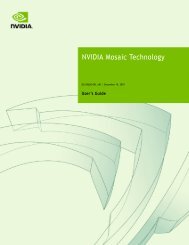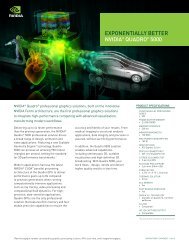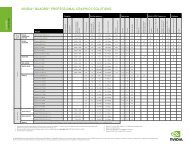NVIDIA Tegra 4 Family CPU Architecture 4-PLUS-1 Quad core
NVIDIA Tegra 4 Family CPU Architecture 4-PLUS-1 Quad core
NVIDIA Tegra 4 Family CPU Architecture 4-PLUS-1 Quad core
You also want an ePaper? Increase the reach of your titles
YUMPU automatically turns print PDFs into web optimized ePapers that Google loves.
Whitepaper<br />
<strong>NVIDIA</strong> <strong>Tegra</strong> 4 <strong>Family</strong> <strong>CPU</strong><br />
<strong>Architecture</strong><br />
4-<strong>PLUS</strong>-1 <strong>Quad</strong> <strong>core</strong><br />
1
Table of Contents<br />
...................................................................................................................................................................... 1<br />
Introduction .............................................................................................................................................. 3<br />
<strong>NVIDIA</strong> <strong>Tegra</strong> 4 <strong>Family</strong> of Mobile Processors ............................................................................................ 3<br />
Benchmarking <strong>CPU</strong> Performance .............................................................................................................. 4<br />
<strong>Tegra</strong> 4 <strong>Family</strong> <strong>CPU</strong>s Architected for High Performance and Power Efficiency ......................................... 6<br />
Wider Issue Execution Units for Higher Throughput ............................................................................ 6<br />
Better Memory Level Parallelism from a Larger Instruction Window for Out-of-Order Execution ...... 7<br />
Fast Load-To-Use Logic allows larger L1 Data Cache ............................................................................. 8<br />
Enhanced branch prediction for higher efficiency .............................................................................. 10<br />
Advanced Prefetcher for higher MLP and lower latency .................................................................... 10<br />
Large Unified L2 Cache ........................................................................................................................ 11<br />
Improved Cortex-A15 Power Efficiency ............................................................................................... 13<br />
Fifth Battery Saver <strong>CPU</strong> Core ............................................................................................................... 14<br />
Conclusion ............................................................................................................................................... 15<br />
APPENDIX ................................................................................................................................................ 16<br />
Document Revision History ......................................................................................................................... 18<br />
2
Introduction<br />
<strong>NVIDIA</strong> led the industry by introducing the <strong>Tegra</strong> ® 2, the first multi-<strong>core</strong> mobile system-ona-chip<br />
(SoC) processor in early 2011, changing the face of mobile computing. As the world’s first<br />
dual-<strong>core</strong> mobile processor, <strong>Tegra</strong> 2 started shipping in tablets and smartphones delivering<br />
higher performance, longer battery life, and a better user experience. With the rapid adoption of<br />
high-end smartphones and tablets, consumers are relying more and more on such devices for<br />
their daily computing and entertainment needs.<br />
With the introduction of the <strong>Tegra</strong> 3, <strong>NVIDIA</strong> shipped the world’s first 4-<strong>PLUS</strong>-1 quad <strong>core</strong><br />
mobile processor. This unique 4-<strong>PLUS</strong>-1 architecture utilizes four <strong>CPU</strong> <strong>core</strong>s for performanceintensive<br />
applications, and one Battery Saver <strong>core</strong> for processing low performance<br />
applications and background tasks when the device is idling. This unique combination delivers<br />
increased performance to consumers to enable full-featured Web browsing, console class<br />
gaming, extreme multitasking, photo editing and video editing, while at the same time increasing<br />
battery life.<br />
The next generation of multi-<strong>core</strong> mobile processors is expected to deliver significantly higher<br />
performance, enabling PC-class productivity, social networking, multimedia, and console-quality<br />
gaming experiences on smartphones and tablets. In addition, operating systems continue to<br />
leverage the increasing performance of mobile processors to deliver new and improved<br />
features, faster, richer, and more efficient user interfaces, and enhanced application<br />
performance.<br />
With the introduction of powerful SoC devices like <strong>Tegra</strong> 4, the processing capabilities of<br />
smartphones, tablets, and notebook PCs are converging, raising consumer expectations for PCclass<br />
performance and uncompromised battery life in their mobile devices. Higher resolution<br />
displays, wireless display solutions such as Miracast, and console-class mobile games will<br />
have consumers using their tablets and smartphones as both portable gaming devices and<br />
family room gaming consoles.<br />
<strong>NVIDIA</strong>’s new <strong>Tegra</strong> 4 family of SoC processors is architected to meet the challenges of this<br />
new crop of mobile use cases.<br />
<strong>NVIDIA</strong> <strong>Tegra</strong> 4 <strong>Family</strong> of Mobile Processors<br />
<strong>NVIDIA</strong> <strong>Tegra</strong> 4 is the world’s first ARM Cortex-A15-based quad <strong>core</strong> <strong>CPU</strong> architecture and<br />
delivers superior performance for demanding mobile applications and improved battery life.<br />
Plus, with the addition of a 2 nd generation Battery Saver <strong>CPU</strong> <strong>core</strong> and Variable Symmetric<br />
Multiprocessing (vSMP) technology, <strong>Tegra</strong> 4 further improves both performance and battery<br />
life.<br />
<strong>Tegra</strong> 4 is both significantly faster than <strong>Tegra</strong> 3, as well as more power efficient, delivering faster<br />
performance and richer graphics while consuming roughly the same amount of power.<br />
3
Figure 1 <strong>NVIDIA</strong> <strong>Tegra</strong> 4 <strong>Family</strong><br />
<strong>NVIDIA</strong> <strong>Tegra</strong> 4i is based on the <strong>Tegra</strong> 4 architecture and it brings the <strong>Tegra</strong> 4 super phone<br />
experiences into the mainstream smartphone, and integrates <strong>NVIDIA</strong>’s LTE i500 SDR modem,<br />
all on a single chip. <strong>Tegra</strong> 4i includes ARM’s newest and most efficient <strong>core</strong>— the Cortex-A9 r4<br />
<strong>CPU</strong>— in a quad-<strong>core</strong> implementation at 2.3 GHz with a fifth battery saver <strong>core</strong>, and is half the<br />
size of the competing quad-<strong>core</strong> integrated LTE mobile processors.<br />
<strong>Tegra</strong> 4i’s new <strong>CPU</strong> was designed by ARM with help from <strong>NVIDIA</strong> and sets new standards for<br />
efficiency and performance while being 2x the performance of the previous revision of Cortex-<br />
A9 found in <strong>Tegra</strong> 3. <strong>Tegra</strong> 4i delivers super-fast Web browsing and quick load time for apps,<br />
along with great battery life.<br />
Benchmarking <strong>CPU</strong> Performance<br />
Benchmarks are typically used to evaluate the performance of a device or a design such that<br />
the benchmark results correlate well with the real world performance of the design. Therefore<br />
when evaluating the performance of a <strong>CPU</strong> architecture, it is essential to ensure that the<br />
workloads used to benchmark the performance of the <strong>CPU</strong> is similar to those presented by real<br />
world applications and programs.<br />
Over the years several benchmarks have been developed to evaluate the performance of<br />
<strong>CPU</strong>s. Two of the well-known benchmarks that have been used for <strong>CPU</strong> benchmarking are<br />
4
Dhrystone MIPS and Coremark. Dhrystone MIPS, also known as DMIPS, is a synthetic<br />
benchmark that was developed about 30 years ago primarily intended to be representative of<br />
<strong>CPU</strong> integer processing performance.<br />
Unfortunately while DMIPS was relevant 30 years ago when <strong>CPU</strong> architectures were much<br />
simpler and tied closely to the speed of external memory, it is now outdated and does not<br />
accurately reflect the performance required of real world applications. There is a significant<br />
issue with DMIPs as a metric – the benchmark code fits entirely in the L1 caches of modern<br />
mobile processors. Thus it does not exercise the L1 cache miss handling logic, L2 cache, or<br />
SoC memory system. The author of the original Dhrystone benchmark has this to say even way<br />
back in 1999:<br />
“ DMIPS cannot claim to be useful for modern workloads as it is so short, it<br />
fits in on-chip caches, and fail to stress the memory system ”<br />
Author of DMIPS benchmark (Weicker), EDN Magazine, 10/28/1999<br />
Similarly, other widely used benchmarks such as Coremark and Linpack are written to test only<br />
one specific portion of the <strong>CPU</strong> performance. Coremark tests only the ALU and FPU<br />
performance while Linpack is only a measure of the performance of the <strong>CPU</strong>’s Floating Point<br />
Unit.<br />
Dhrystone MIPS exercises only<br />
a small portion of the <strong>CPU</strong><br />
complex and runs entirely in<br />
the Instruction Cache<br />
Figure 2 Dhrystone MIPS benchmarks only a small section of the <strong>CPU</strong> complex<br />
5
A more representative benchmark of true <strong>CPU</strong> performance is the SPECint benchmark. It was<br />
written to specifically use the kernels of real world applications such as file compression, word<br />
processing, gaming, database management, and many more instead of using synthetic tests.<br />
SPECint exercises almost all of<br />
the <strong>CPU</strong> complex including<br />
the memory controller and is<br />
representative of real world<br />
<strong>CPU</strong> workloads<br />
Figure 3 SPECint exercises the entire <strong>CPU</strong> complex and has workloads that are similar to real world applications<br />
<strong>Tegra</strong> 4 <strong>Family</strong> <strong>CPU</strong>s Architected for High Performance and Power<br />
Efficiency<br />
Current generation mobile applications are stretching the performance capabilities of today’s<br />
mobile processors. The transition to multi-<strong>core</strong> <strong>CPU</strong> architecture and higher operating<br />
frequencies have increased processor capabilities to meet growing performance needs. But, the<br />
next generation of PC-class mobile applications requires a new <strong>CPU</strong> architecture that not only<br />
has sufficient headroom to meet growing performance needs, but also continues to stay within<br />
mobile power budgets.<br />
Both the Cortex-A15 <strong>CPU</strong> architecture in <strong>Tegra</strong> 4 and the Cortex-A9 r4 <strong>CPU</strong> architecture in<br />
<strong>Tegra</strong> 4i have several enhancements over the current generation architectures, providing up to<br />
two times the performance of current solutions in their respective device classes. Some of the<br />
key enhancements in these architectures are described below.<br />
Wider Issue Execution Units for Higher Throughput<br />
The Cortex-A15 <strong>CPU</strong> architecture has eight execution units, and is capable of issuing eight<br />
instructions per clock compared to five on Cortex-A9. However, the execution units are of little<br />
value unless they can be effectively used. In order to fully benefit from the higher number of<br />
6
execution units, the architecture needs to support deeper Out-Of-Order execution for better<br />
Instruction Level Parallelism (ILP), and for earlier detection of cache misses to increase Memory<br />
Level Parallelism (MLP). It should also have accurate branch prediction capabilities to improve<br />
work efficiency.<br />
Figure 4 Eight Execution Units on ARM Cortex-A15 <strong>CPU</strong><br />
Better Memory Level Parallelism from a Larger Instruction Window for Out-of-Order<br />
Execution<br />
<strong>CPU</strong> performance is heavily dependent on reducing the latency to memory. The performance<br />
efficiency of a <strong>CPU</strong> drops significantly if the <strong>CPU</strong> is idle and waiting for data to be fetched from<br />
memory. Therefore, it is important to not only reduce the number of cache misses (that trigger<br />
data fetches from memory) with larger and more effective <strong>CPU</strong> caches, but also to increase the<br />
Memory Level Parallelism (MLP - the number of data fetches from system memory happening<br />
concurrently). The effective latency in fetching data from system memory back to the <strong>CPU</strong> is<br />
equal to the latency for one memory fetch, divided by the number of memory fetches that can be<br />
executed in parallel (MLP).<br />
To improve <strong>CPU</strong> performance efficiency it is therefore important to look ahead many<br />
instructions, and issue Load instructions that may miss in the caches. The larger the Out-Of-<br />
Order lookup window, the greater are the chances of finding such a Load.<br />
7
Figure 5 Relationship between Memory Level Parallelism and OoO Window lookup size<br />
Figure 3 shows the importance of being more aggressive in <strong>CPU</strong> architecture when using a<br />
larger OoO window. Both memory operations and branches should be executed out-of-order in<br />
order to maximize the available MLP in an application.<br />
The Cortex-A15 architecture has a large 128 micro-op lookup window that significantly improves<br />
MLP, and execute branches and some memory operations out-of-order (for a majority of ARM<br />
instructions there is a one-to-one mapping between instructions and micro-ops, but some of the<br />
more complex CISC-like instructions include two or more operations that can be expanded). In<br />
comparison, the Qualcomm Krait processor architecture has only a 40 instruction OoO window,<br />
limiting its capability for MLP.<br />
Note that all memory operations can complete out of order, the only restriction on OoO memory<br />
operation issue is that the address must be known for older stores, so A15 lies close to the fully<br />
OoO green line on the graph above.<br />
Fast Load-To-Use Logic allows larger L1 Data Cache<br />
A critical path in modern <strong>CPU</strong> design is the load-to-use path, where an operation is dependent<br />
on the result of a preceding load. This path has a number of complex steps:<br />
<br />
Add to compute address<br />
8
Translate address from virtual to physical<br />
Compare address to the tag contents<br />
Select the critical data from the resulting cache line<br />
Align that data to the required register<br />
Cortex-A15 combines the logic for add and translate steps using a highly efficient logic design<br />
that generates only enough data to determine if the compare hits without the full (and slow) add<br />
operation. Combining these steps speeds up the load-to-use path, and permits implementation<br />
of a high speed 32KB L1 Data cache, even though large L1 caches typically must run at lower<br />
clock rates than smaller caches. Indeed, competing architectures like Krait are limited to a<br />
16KB L1 Data cache. Figure 6 shows the effect of data cache size on SPECint tests, showing<br />
the importance of a 32K data cache.<br />
Cortex-A9 r4 combines the same logic and 32K cache, and also increases the TLB size to 512<br />
entries to match A15.<br />
<br />
<br />
<br />
Cortex-A15 and Cortex-A9 r4 support a highly efficient loadto-use<br />
path<br />
Cortex-A15 and Cortex-A9 r4 have 32KB L1 Data Cache<br />
Cortex-A9 r4 also has the larger TLB (translation lookaside<br />
buffer) of the Cortex-A15<br />
Figure 6 Impact of Data Cache size on cache miss rates and <strong>CPU</strong> performance<br />
9
Enhanced branch prediction for higher efficiency<br />
Accurate Branch Prediction is critical for OoO efficiency, both to extract MLP, and to avoid<br />
wasted work. Cortex-A15 has an advanced branch prediction mechanism with the following<br />
features:<br />
<br />
<br />
<br />
<br />
<br />
A bi-mode predictor to reduce interference between aliased branches that branch in<br />
opposite directions. Bi-mode predictors are broadly described on the Internet for those in<br />
search of further details.<br />
Branches resolve OoO to fix speculation errors sooner, to avoid wasted work.<br />
Return Address Stack correction from speculative pops and pushes. An aggressive outof-order<br />
machine like A15 can corrupt the return address stack with speculative calls and<br />
returns, and therefore has a mechanism to correct mis-speculation.<br />
Indirect Branch Prediction mechanism. Indirect branches are common for the<br />
interpreters required for Web languages. To better predict such branches A15 has a<br />
separate structure that is accessed based on PC and history for the target.<br />
Finally, a static prediction mechanism is required to predict cold BTB misses.<br />
The Cortex-A9 r4 architecture has the same larger history register as A15, and the same<br />
predictor structure sizes. These enhancements help the Cortex-A9 r4 <strong>CPU</strong> to deliver prediction<br />
accuracy that is similar to that of the Cortex-A15 architecture.<br />
<br />
Cortex-A9 r4 matches Cortex-A15 branch prediction<br />
performance by increasing the History Buffer and Saturating<br />
counters<br />
Advanced Prefetcher for higher MLP and lower latency<br />
Another method used in advanced processors to increase MLP is a hardware pre-fetcher. By<br />
predicting the data required in advance of its use, a pre-fetcher can decrease memory latency<br />
and increase MLP. In particular, there are common situations that that an out-of-order machine<br />
cannot detect. For example, if the program is following a linked list on a regular structure<br />
through memory, the successive loads cannot be issued until the previous load has completed<br />
to give the address. A stride detecting pre-fetcher will be able to load this data in advance.<br />
Cortex-A15 has one hardware pre-fetcher per <strong>CPU</strong> in the L2 controller. Importantly, it uses both<br />
the program counter (PC) and the address bits to detect strided access, and to avoid aliasing<br />
between different threads that would occur without the use of the PC.<br />
10
It will perform a programmable number of prefetches, and has a hardware throttling mechanism<br />
to avoid resource hogging.<br />
Cortex-A9 r4 has a new L1 pre-fetcher in each <strong>CPU</strong>, similarly using both the PC and address. It<br />
has dedicated buffers so it does not allocate into the L1 D-cache until the data hits. It will check<br />
its own effectiveness and back off when ineffective, and can track multiple streams.<br />
<br />
<br />
Cortex-A9 r4 includes an L1 data Prefetcher<br />
The Cortex-A9 r4 Pre-fetcher has dedicated prefetch buffers and is<br />
capable of tracking multiple prefetch streams<br />
Large Unified L2 Cache<br />
Caches are used on <strong>CPU</strong>s to reduce the number of off-chip accesses to system memory.<br />
Caches store the most frequently used data on-chip enabling the <strong>CPU</strong> to access the data faster<br />
and improving the performance and efficiency of the <strong>CPU</strong>. Each <strong>core</strong> of the quad <strong>core</strong> ARM<br />
Cortex-A15 <strong>CPU</strong> complex on <strong>NVIDIA</strong> <strong>Tegra</strong> 4 has its own 32KB Instruction cache and 32KB of<br />
Data cache. All four <strong>core</strong>s share a common large 2MB L2 cache, which is 16-way set<br />
associative. The large 128 entry deep Out-off-order buffer allows the L2 cache latency to be<br />
largely hidden. Along with the 32KB L1 Caches, the 2MB L2 cache works to minimize off-chip<br />
fetches to system memory, both increasing performance and reducing power as DRAM fetches<br />
are more power intensive than on-chip SRAM fetches.<br />
The quad <strong>core</strong> Cortex-A15 architecture is uniquely different from that of the Qualcomm Krait<br />
architecture in its implementation of the L2 cache. Unlike Krait, the entire 2MB cache on <strong>NVIDIA</strong><br />
<strong>Tegra</strong> 4 is fully shared across all four <strong>core</strong>s. Depending on the workload, the allocated space for<br />
each <strong>core</strong> can be dynamically changed completely under hardware control. For example, on<br />
<strong>Tegra</strong> 4, one <strong>core</strong> could be allocated 1280KB while the other three <strong>core</strong>s could be assigned<br />
256KB each for a total of 2MB. Similarly if a multi-thread application is sharing a common data<br />
structure, all four <strong>core</strong>s may access the same L2 cache lines. This workload-based allocation of<br />
L2 Cache space improves the efficiency of L2 cache and helps further reduce cache miss rates.<br />
11
Figure 7 Entire 2MB L2 cache can be dynamically allocated to any <strong>CPU</strong> on <strong>NVIDIA</strong> <strong>Tegra</strong> 4<br />
Krait on the other hand, due to the limitation of its Asynchronous SMP architecture, statically<br />
allocates a fixed 512KB of L2 cache for each <strong>CPU</strong> <strong>core</strong>. When a <strong>CPU</strong> <strong>core</strong> on Krait uses more<br />
than 512KB of data, it is forced to incur higher levels of L2 cache misses resulting in costly data<br />
fetches to system memory. The impact of the smaller static 512KB cache on Krait performance<br />
is easily seen on <strong>CPU</strong> benchmarks such as SPECint2K that mimic real world application<br />
performance.<br />
Further, when a thread migrates from one <strong>core</strong> to another, the <strong>core</strong> needs to fetch data from<br />
another <strong>core</strong> L2 and migrate it to the local L2. This inter-<strong>core</strong> traffic is subject to a significant<br />
additional delay due to the clock domain-crossing synchronizers required between each <strong>core</strong> on<br />
the Asynchronous SMP boundary.<br />
Figure 8 Asynchronous SMP prevents Krait from allocating the entire L2 to a single <strong>CPU</strong> <strong>core</strong><br />
12
Improved Cortex-A15 Power Efficiency<br />
In addition to the features that deliver higher levels of performance, the Cortex-A15 <strong>CPU</strong><br />
architecture includes several architectural enhancements that deliver higher power efficiency<br />
than current architectures.<br />
The A15 architecture implements a large 32 entry Loop Buffer for active power management.<br />
Instruction fetches, Instruction Decodes, and Branch Prediction on Cortex-A15 consume about<br />
forty percent of <strong>CPU</strong> power. When the <strong>CPU</strong> is executing out of the Loop buffer these three<br />
elements are disabled and clock-gated off. Refer to the figure below.<br />
Branch<br />
Prediction<br />
Instruction<br />
fetch<br />
Misc<br />
Instruction<br />
decode<br />
Register<br />
Rename<br />
Miss<br />
Handling<br />
Issue Queue<br />
and<br />
Operand<br />
Read<br />
Integer<br />
execution<br />
ROB<br />
Data cache<br />
Figure 9 Deep Loop Buffer helps save almost fifty percent of front-end power consumed in a <strong>CPU</strong> <strong>core</strong><br />
Cortex-A15 balances performance and power by limiting Out-of-order instruction issue in cases<br />
where the power consumption is too high to justify the performance gain for mobile workloads.<br />
For example, a load instruction is not issued before older store instructions and new store<br />
instructions are not issued before older store instructions are executed. This avoids a power<br />
hungry memory disambiguation structure.<br />
In addition, extensive clock and power gating is implemented across the design including the L1<br />
and L2 caches to further reduce power consumption.<br />
13
Fifth Battery Saver <strong>CPU</strong> Core<br />
In addition to the four high-performance <strong>CPU</strong> <strong>core</strong>s, the <strong>NVIDIA</strong> <strong>Tegra</strong> 4 <strong>Family</strong>’s <strong>Quad</strong> <strong>core</strong><br />
<strong>CPU</strong> architecture includes a fifth low power Battery Saver <strong>CPU</strong> <strong>core</strong>. The fifth Battery Saver<br />
<strong>CPU</strong> <strong>core</strong> in this architecture is optimized for low power consumption and is built using<br />
transistors that require lower power to operate. The Battery Saver <strong>core</strong> is exceptionally powerefficient,<br />
and is focused on managing a wide variety of tasks that have low performance<br />
requirements, such as background email syncs, social media syncs, audio playback, video<br />
playback, book reading, and more.<br />
The Battery Saver <strong>core</strong> is designed to handle low performance tasks and these tasks typically<br />
don’t fully utilize the 2MB L2 cache. To further save power the Battery Saver <strong>core</strong> has its own<br />
512KB L2 cache. When the main <strong>CPU</strong> <strong>core</strong>s are turned off, the 2MB L2 cache is flushed and<br />
power gated to save power. The Battery Saver <strong>core</strong> operates using the smaller and lower power<br />
512KB L2 cache.<br />
In cases where the performance requirements do not justify the use of the high performance<br />
quad <strong>core</strong> A15 <strong>CPU</strong> complex, <strong>Tegra</strong> 4 completely switches off the main quad <strong>CPU</strong> complex and<br />
switches to the Battery Saver <strong>core</strong>. The switching between the main quad <strong>core</strong> A15 <strong>CPU</strong><br />
complex and the Battery Saver <strong>CPU</strong> <strong>core</strong> is managed by <strong>NVIDIA</strong>’s second generation Variable<br />
Symmetric Multiprocessing (VSMP) technology that delivers high levels of power efficiency<br />
compared to the Qualcomm Krait architecture, which is based on Asynchronous SMP<br />
technology.<br />
<strong>NVIDIA</strong> <strong>Tegra</strong> 4’s 4+1 quad <strong>core</strong> processor based on vSMP technology delivers significant<br />
architectural benefits:<br />
<br />
Cache Coherency: vSMP technology does not allow both the Battery Saver Core and<br />
the main performance <strong>core</strong>s to be enabled at the same time, so there are no penalties<br />
involved in synchronizing caches between <strong>core</strong>s running at different speeds. ASMP<br />
incurs cache synchronization penalties when <strong>core</strong>s operating at higher frequencies<br />
attempt to synchronize data with <strong>core</strong>s running at much lower frequencies. This not only<br />
impacts the performance of the <strong>core</strong>(s) operating at higher frequency, but also adds<br />
additional synchronizing hardware between <strong>core</strong>s resulting in higher power<br />
consumption.<br />
Moreover, to accommodate asynchronous clocking, Krait architecture resorts to static L2<br />
cache allocation, limiting the available L2 cache space for each <strong>CPU</strong> <strong>core</strong> to just 512KB.<br />
The reduced available cache space impacts the L2 cache hit percentage, and results in<br />
higher power consumption due to more off-chip memory fetches and higher memory<br />
latencies that impact <strong>CPU</strong> performance.<br />
OS Efficiency: Android OS and WinRT OS assume all available <strong>CPU</strong> <strong>core</strong>s are identical<br />
with similar performance capabilities. Based on this assumption, the OS schedules tasks<br />
to various <strong>CPU</strong> <strong>core</strong>s. When multiple <strong>CPU</strong> <strong>core</strong>s are each run at different asynchronous<br />
frequencies, it results in the <strong>core</strong>s having differing performance capabilities. This could<br />
lead to OS scheduling inefficiencies. In contrast, vSMP technology always maintains all<br />
14
active <strong>core</strong>s at a similar synchronous operating frequency for optimized OS scheduling.<br />
Even when vSMP switches from the battery saver <strong>core</strong> to one or more of the main <strong>CPU</strong><br />
<strong>core</strong>s, the <strong>CPU</strong> management logic ensures a seamless transition that is not perceptible<br />
to end users and does not result in any OS scheduling penalties.<br />
For more details on <strong>NVIDIA</strong> <strong>Tegra</strong>’s 4+1 <strong>CPU</strong> architecture and vSMP technology, please refer to<br />
the whitepaper titled Variable SMP – A Multi-Core <strong>CPU</strong> architecture for High Performance and<br />
Low Power.<br />
Conclusion<br />
Smartphones and tablets are increasingly being used as personal computing devices. Today’s<br />
smartphones are no longer being used for just phone calls, messaging, and light Web browsing.<br />
Mobile applications for PC-class use cases such as photo editing, word processing, multitabbed<br />
Web browsing, modern graphics-rich gaming, and multi-tasking are now available for<br />
mobile devices and are pushing the performance requirements of these devices. The quad <strong>core</strong><br />
<strong>CPU</strong>s in <strong>NVIDIA</strong> <strong>Tegra</strong> 4 family of mobile SoCs include several key enhancements that deliver<br />
higher performance for the next generation of mobile applications. The quad <strong>core</strong> Cortex-A15-<br />
<strong>CPU</strong> complex in <strong>Tegra</strong> 4 includes more execution resources for better instruction level<br />
parallelism, larger out-of-order windows, and smarter branch prediction for lower latencies and<br />
higher efficiencies. It also includes a large data cache, and larger L2 cache to improve overall<br />
data and instruction access speed and reduce penalties associated with cache misses.<br />
The quad <strong>core</strong> Cortex-A9 r4 processor in <strong>Tegra</strong> 4i includes several Cortex-A15 class<br />
enhancements such as improved branch prediction with larger history buffers, larger TLB size,<br />
and a prefetcher unit to deliver much higher performance and power efficiencies than the<br />
standard Cortex-A9 architecture.<br />
The benefits of these enhancements are easily seen in benchmark results of the industryaccepted<br />
SPECint2000 benchmark, that was designed to mimic the workloads presented by<br />
real applications such as word processing, gaming, databases, file compressions, and more.<br />
The results of SPECint2000 and other benchmarks highlight that the <strong>Tegra</strong> 4 family of quad <strong>core</strong><br />
<strong>CPU</strong> architectures deliver higher performance than competing architectures on workloads that<br />
are expected to be seen in next generation of mobile applications.<br />
More importantly, <strong>Tegra</strong> 4 family of processors delivers exceptional power efficiency and<br />
consumes thirty percent lower power than the previous generation <strong>Tegra</strong> 3 processor while<br />
executing the same workload 1 .<br />
1 Based on SoC plus memory power consumed on <strong>Tegra</strong> 3 and <strong>Tegra</strong> 4 development platforms at the same level of<br />
SPECint2000 performance.<br />
15
APPENDIX<br />
Figure 10 Performance of <strong>Tegra</strong> 4 vs Competition on <strong>CPU</strong> and Web Benchmarks 2<br />
Benchmark<br />
Result<br />
<strong>CPU</strong> & System SpecINT2000 1168<br />
Sunspider 0.91<br />
506 milli-seconds<br />
Web Page Load<br />
28 seconds<br />
WebGL Aquarium (50 fish)<br />
60 fps<br />
Google Octane 4582<br />
Kraken 1.1<br />
6799 milli-seconds<br />
Geekbench 1.0 4285<br />
Antutu 3.1.1 36127<br />
<strong>Quad</strong>rant Pro 2.0 16449<br />
CFBench 1.1 41227<br />
GPU GLBench 2.5 HD Egypt (1080p offscreen) 57 fps<br />
GLBench 2.5 HD Classic (720p offscreen) 274 fps<br />
Basemark ES 2 Hoverjet<br />
59 fps<br />
Table 1 Measured <strong>Tegra</strong> 4 Benchmark Results<br />
2 <strong>Tegra</strong> 4 s<strong>core</strong>s measured on <strong>Tegra</strong> 4 development platform. Sunspider s<strong>core</strong> for S600 is from published results.<br />
Other s<strong>core</strong>s measured on S4 Pro retail device and scaled to S600 specs. S800 s<strong>core</strong>s are scaled up from S600 based<br />
on higher clock frequency and IPC claimed by Qualcomm<br />
16
Document Revision History<br />
Revision Number<br />
Notes<br />
18
Notice<br />
ALL INFORMATION PROVIDED IN THIS WHITE PAPER, INCLUDING COMMENTARY, OPINION, <strong>NVIDIA</strong> DESIGN<br />
SPECIFICATIONS, REFERENCE BOARDS, FILES, DRAWINGS, DIAGNOSTICS, LISTS, AND OTHER DOCUMENTS<br />
(TOGETHER AND SEPARATELY, “MATERIALS”) ARE BEING PROVIDED “AS IS.” <strong>NVIDIA</strong> MAKES NO WARRANTIES,<br />
EXPRESSED, IMPLIED, STATUTORY, OR OTHERWISE WITH RESPECT TO MATERIALS, AND EXPRESSLY DISCLAIMS ALL<br />
IMPLIED WARRANTIES OF NONINFRINGEMENT, MERCHANTABILITY, AND FITNESS FOR A PARTICULAR PURPOSE.<br />
Information furnished is believed to be accurate and reliable. However, <strong>NVIDIA</strong> Corporation assumes no responsibility for the<br />
consequences of use of such information or for any infringement of patents or other rights of third parties that may result from its<br />
use. No license is granted by implication or otherwise under any patent or patent rights of <strong>NVIDIA</strong> Corporation. Specifications<br />
mentioned in this publication are subject to change without notice. This publication supersedes and replaces all information<br />
previously supplied. <strong>NVIDIA</strong> Corporation products are not authorized for use as critical components in life support devices or<br />
systems without express written approval of <strong>NVIDIA</strong> Corporation.<br />
Trademarks<br />
<strong>NVIDIA</strong>, the <strong>NVIDIA</strong> logo, <strong>Tegra</strong> and 4-<strong>PLUS</strong>-1 are trademarks or registered trademarks of <strong>NVIDIA</strong> Corporation in the United States<br />
and other countries. Other company and product names may be trademarks of the respective companies with which they are<br />
associated.<br />
Copyright<br />
© 2013 <strong>NVIDIA</strong> Corporation. All rights reserved.<br />
19




